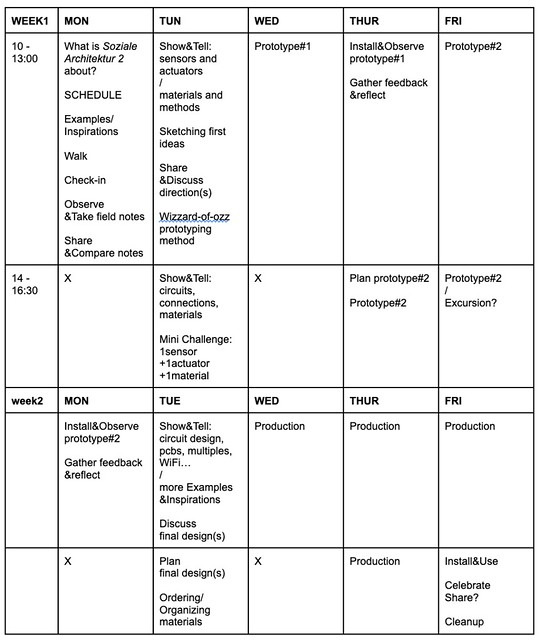Soziale Architektur 2 WS24

Soziale Architektur II
Spiel und Objekt 3Jhg, Hannah Perner Wilson
15-26.1.2024, 10-13/16:30, Ladenlokal
Architecture is described as the art and technique of designing and building our environments. We may think of architecture as something big that surrounds us, contains us, creates spaces within which we can move and interact with others. But the smallest elements that populate our surroundings are also architectures that shape our social interactions and everyday experience of reality.
In this two week course we will take a good look at our surroundings, observe how people interact with and within them as well as reflect on our own use of these spaces. We will build/extend/modify these surroundings and observe what influence we can have on human behaviors and experiences.
Our material/technology of choice will be physical computing - combining sensors, actuators and code with materials such as paper, wood and textiles. What we build may be big enough to contain a few of us or small enough to swallow.
CONTENTS
Interaction design
we will spend a lot of time observing as well as building things to observe. Because people aren’t very good at remembering or describing their own behaviors we can learn a lot from simply watching them. And because the less we interfere, the better we can get at how people actually interact and not how we expect them to interact. We will use drawing as a tool for observation and imagination. Apply the wizard-of-ozz prototyping method for quickly testing silly ideas. And do playtests in the field.
Technology
we will open things up to look at how they work. We will get to know many sensors and actuators as well as how to make our own. We will look at code and libraries for debouncing, smoothing, and calibrating sensor readings as well as for moving, blinking, flashing, writing to and speaking through actuators.
Making
takes time. We will look at various options for connecting electronics in robust and beautiful ways. How to handmake sensors, actuators and circuitboards. And take a quick look at PCB design tools and work-flows for producing multiples. We will iterate through a series of prototypes so that we don’t start with a grand plan and end with a useless device. Rather we will take small steps so that we can fail often before arriving somewhere completely unexpected.
Discussion
inbetween the making and observing we will find time to chat about what we are making and why.
Documentation
sharing is caring. As we benefit from other people’s documentation - step-by-step tutorials, component datasheets, code repositories, wikipedia articles... We will take time to consider what we can give back, and make use of Spiel und Object’s Hyperdramatic wiki for sharing what we can.
What is Soziale Architektur 2 about?
An opportunity for Spiel und Object years to make something (useful?) for themselves and/or others. While learning new skills and making mistakes. To enjoy making something (big) together. To leave something behind for future years. Can it also fail? Would that also be okay? /It can also fail! That would also be okay.
Previous years
http://hyperdramatik.net/mediawiki/index.php?title=Soziale_Architektur_2
This year / my input
Iterative process. Practice observation skills for idea generation and evaluation (useful later in playtests) Make it Interactive: with “physical computing” - functional & beautiful combination of materials and electronics. Make it well, make it playful, make it beautiful.
3 Spaces - 3 Audiences
LL(personal) windows/street(public) HfSinside/out(institution) +Use LL windows as public work-in-process documentation/story
SCHEDULE
Rough schedule draft:

SCHEDULE == FLEXIBLE
DAY1
Examples&Inspiration: bombard you with examples (see bellow)
Talk about (user) observation & field notes
Take a walk and reflect on: what you just saw what you initially thought what you would like to make how you would like to spend these two weeks
Return and discuss what you could observe to generate ideas.
Wander around, observe and take field notes. P.O.E.M.S. FIELD NOTES - describe in great detail, interpret what you see (because you are never objective and always anyway interpreting) DRAWING as observation technique USE YOUR SENSES - close your eyes, what do you hear, smell, sense…?
(Return and share/compare notes)
Tape notes to LL windows.
//End day1//
DAY2
Share/compare notes.
How to transition from research to artistic/design ideas?
Show&Tell
OBSERVATION
Ethnography - writing culture / portrait of people
qualitative research, observation
playtesting
Sampling bias Sample skewed - people are not Location not representative of larger view Time - not everything is true all the time Theoretical bias Preconceived notions of researcher when selecting subjects, location… Personal bias Researcher personality colours how we perceive what we see
What are the 4 types of observation in sociology? The 4 main types of observation in sociology are participant observation, non-participant observation, covert observation, and overt observation.
Field Notes
AEIOU Observation Framework https://openpracticelibrary.com/practice/aeiou-observation-framework/
POEMS https://spin.atomicobject.com/poems-template-user-observation/
METHODS
REFERENCES
Getting Started In Electronics by Forrest M. Mims available for free pdf on internet
There Are No Electrons: Electronics for Earthlings by Kenn Amdahl (1991) An off-beat introduction to the workings of electricity for people who wish Richard Brautigan and Kurt Vonnegut had teamed up to explain inductance and capacitance to them.
Power Button: A History of Pleasure, Panic, and the Politics of Pushing
On Playtesting
ETHNOGRAPHIC DRAWING: ELEVEN BENEFITS OF USING A SKETCHBOOK FOR FIELDWORK by KARINA KUSCHNIR https://karinakuschnir.files.wordpress.com/2016/10/kuschnir-2016-visual-ethnography-article.pdf